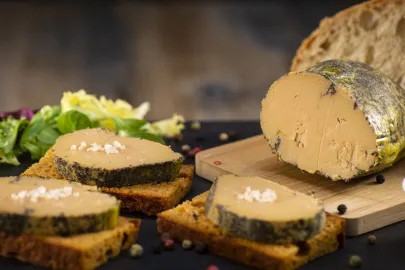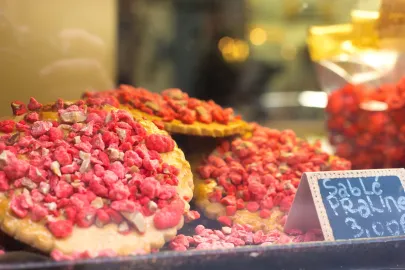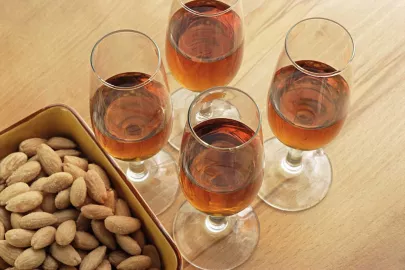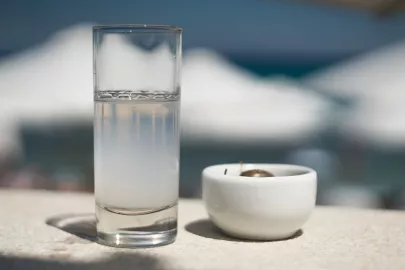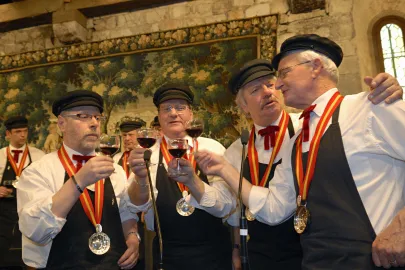The French are great at many things, particularly those of the gustatory variety—when it comes to wine and spirits specifically, there’s an entire world of history, craft, and prestige to explore, seemingly to no end. Of course, no extreme French bar cart would be complete without the wisdom of iconic Parisian bartender Nico de Soto—here, we explore the key elements of Frenchifying your bar cart one bottle at a time, including personal recommendations from de Soto himself.

Haute tips on making your home bar as French as humanly possible.
In fact, when we set out to create the Frenchest bar cart of all time, the task proved relatively easy thanks to the wide range of options within broader categories such as brandies and whiskeys, and within more niche products like ultra-specific liqueurs (that’s kind of our thing).
Cognac
As far as brandies go, there’s really nothing more French than Cognac—a grape spirit made primarily from the region's top three white grape varieties (Ugni Blanc, Colombard, and Folle Blanche). De Soto is a fan of the Pierre Ferrand range of Cognacs in general, but if you’re new to the category, try the 1840 Original Formula, a perfectly approachable Cognac for both sipping and stirring or shaking into your favorite classic drink. Sidecar, anyone?
Gin
Gin might not be the first thing that comes to mind when we talk about French drinking culture, but Citadelle—a go-to for de Soto—is an exceptional brand that’s made in the heart of the Cognac region and shares the same DNA as our previous pick under the Maison Ferrand umbrella. Self-described as a “gin de château,” Citadelle’s original expression is a beautiful, delicately floral gin made using juniper berries harvested at the estate along with other botanicals like violet, lemon peel, orange peel, and cubeb pepper using proprietor Alexandre Gabriel’s patented infusion process. This is as French as it gets as far as gin goes, and personally makes us feel like we’ve regained some power after letting the true French 75 (made with Cognac) fall victim to the English and their drinking habits.
Rhum Agricole
First things first: let’s clarify the difference between “rum” and “rhum” so as to avoid any confusion, especially as the two are distinctly different in flavor profile, broadly speaking. “Rhum” with an “h” indicates a sugar cane spirit that’s been made in the French agricultural-style using fresh cane juice versus molasses (a byproduct of sugarcane). Switch that around, and you’ve got the more widely-known cane spirit, rum.
There are many great rhum agricoles on the market today, most of which are produced within French territories like Guadeloupe, Martinique, and Réunion, though you can also find agricole-style rhums made in other parts of the world (think Australia and Hawaii). According to de Soto, Rhum Père Labat is among the very best—produced at Distillerie Poisson on the Guadeloupean island of Marie-Galante, where all workers are paid regulated and equal wages, this spirit is distilled in one of two copper Creole column stills and is available in several different expressions. Try the Père Labat 59 for fresh, bright drinks like the classic Daiquiri, or go for something with a bit of age on it (such as the Cuvée Spéciale) for sipping neat or on the rocks.
Whisky
Single malt whisky is, of course, synonymous with Scotland, but France is actually one of the category’s biggest consumers on the map. And now, with plenty of French single malt producers throughout the country, it can be tough to choose just one top pick. De Soto is partial to Domaine des Hautes Glaces from the French Alps (the Trièves Mountains, to be exact), where its eponymous organic farm distillery uses a combination of grains like barley, spelt, and rye to sustainably produce a variety of seriously aromatic whiskies. Female-owned French single malt whisky brand Brenne is a crowd favorite amongst industry professionals as a whole, and we recommend stocking at least one bottle of each for late-night digestifs with friends.
Calvados
Ahh, Calvados. Pride of Normandy and beloved by bartenders everywhere—despite having the warm, inviting aura of Mamie’s freshly-baked tarte Tatin, this apple brandy was once used to make explosives during World War I, so don’t let it fool you. Keep a great bottle around (de Soto recommends Calvados Drouin) for a good old trou Normand, or as a secret weapon for Frenchifying your cocktails—try using it as your base in sours, flips, Crustas, and more, especially where other apple and spice flavors are part of the mix.
French Vermouth
In general, no bar cart is complete without at least two vermouths (dry and sweet), although technically, they should be kept in the fridge after opening to preserve freshness. Noilly Prat is a Merseillan-based vermouth producer that’s been around since the early 19th century, and bartenders across the world often reach for it over other brands when on the job. Call it patriotism, sure, but de Soto is a proponent of Noilly Prat for its quality and flavor profiles, both of which can differ greatly from brand to brand. The Noilly Prat Original Dry features 20 different herbs and spices from around the world and is delicious both in cocktails and over ice; its sweet counterpart, Rouge, is made using ingredients like Sri Lankan cinnamon and Venezuelan cocoa beans for a rich-yet-balanced addition to Manhattans and more. If you’re serious about your at-home bartending, be sure to stock up—you’ll go through these bottles faster than you’d think.
French Liqueurs
Liqueurs play a significant role in France’s drinking culture—in fact, you’d be hard-pressed to find a bar without at least one bottle of crème de cassis, for example, which is essential to the Kir and Kir Royale. Vieux Pontarlier absinthe, says de Soto, is also a must, as is Suze, a bitter French gentian apéritif used often in his bars around the world.
Last Words
In short, there’s no right or wrong way to Frenchify your home bar (unless you’re on the rigid side of the “being French” spectrum, that is). Drinking should be about having fun—responsibly, of course—so don’t be afraid to take our ideas and make them your own. But, if you really want to go over the top in Frenchifying your home cocktail experience, de Soto has one more hot tip: “Serve it with a baguette.”
Contributor

Journalist - Editor



